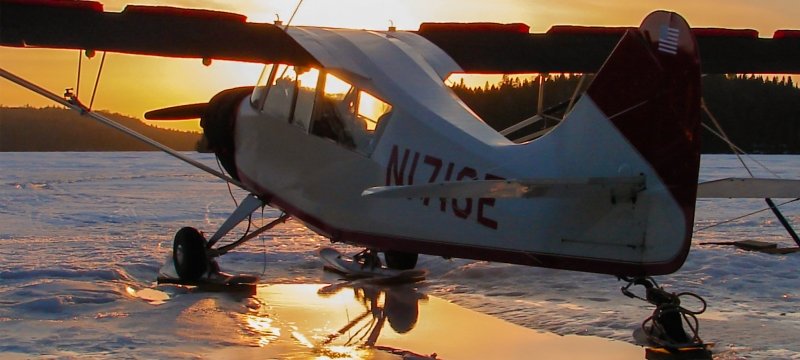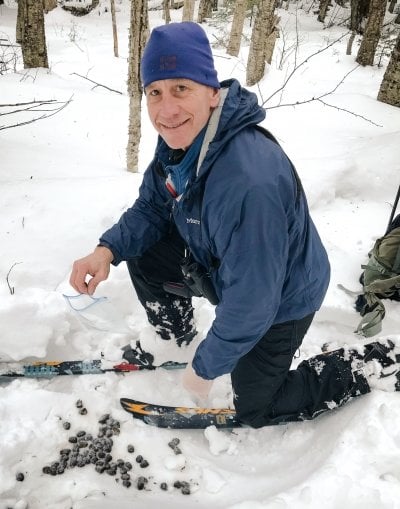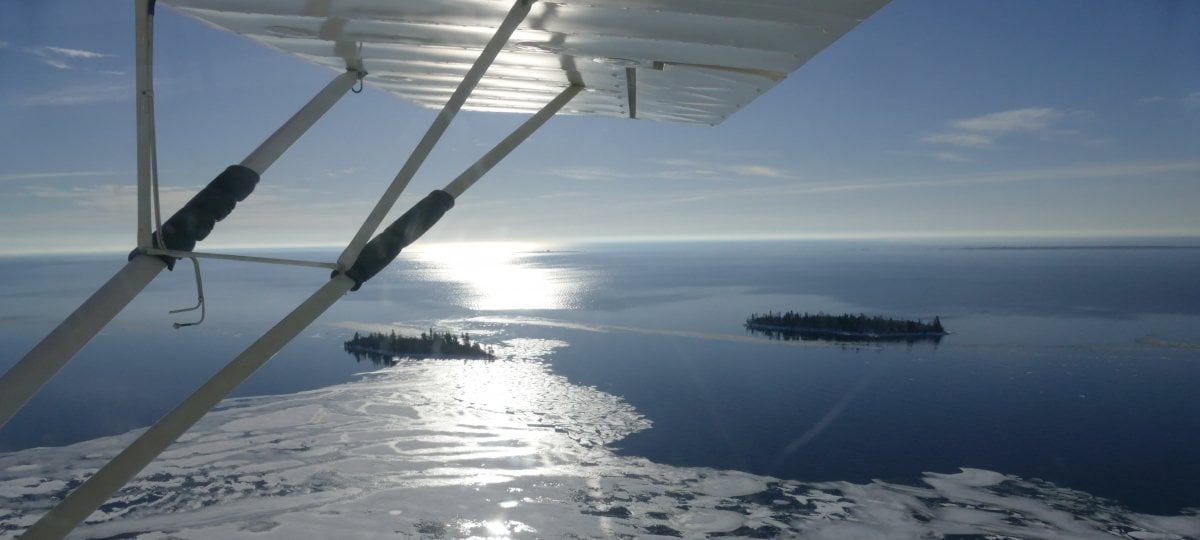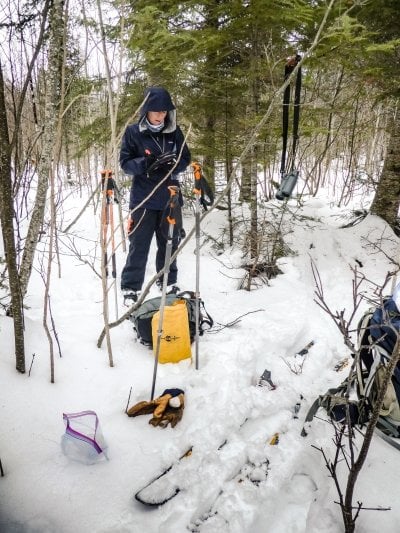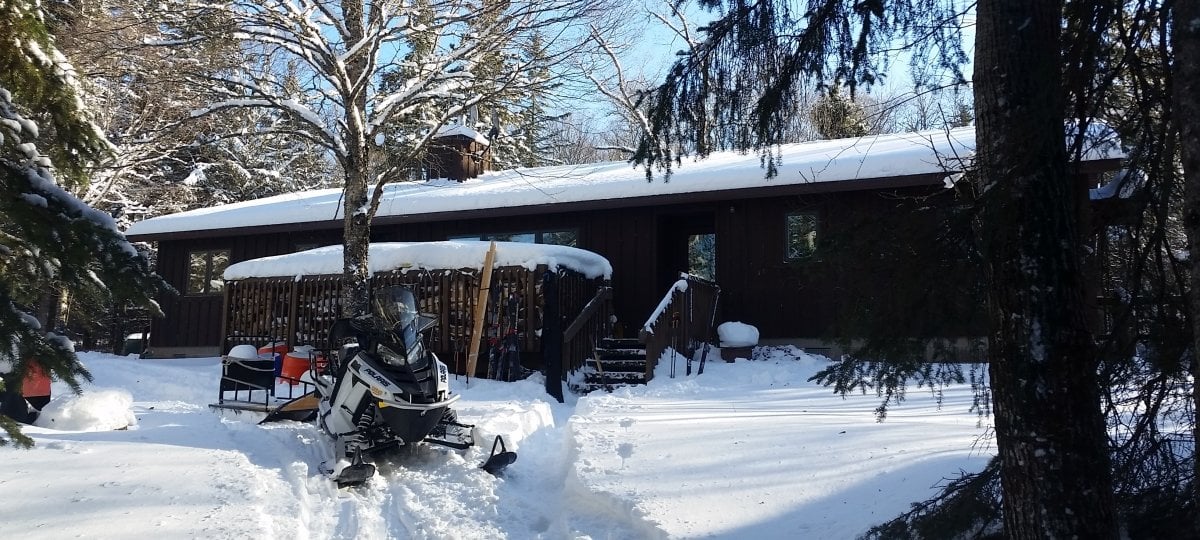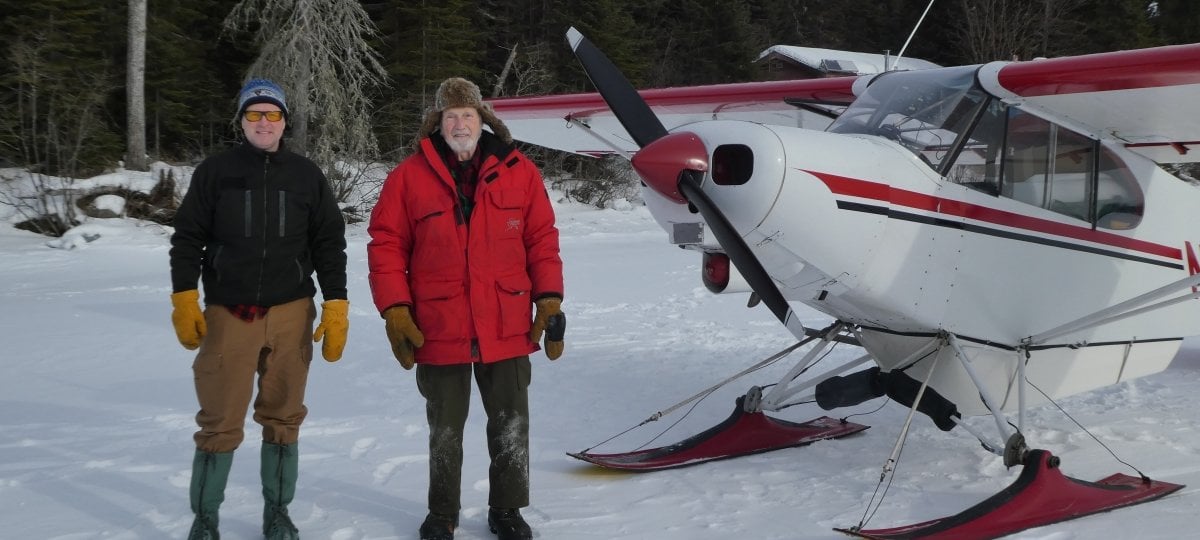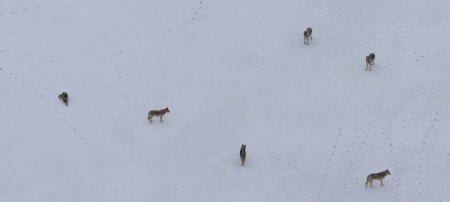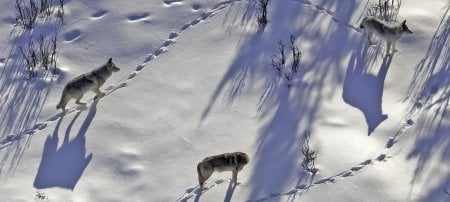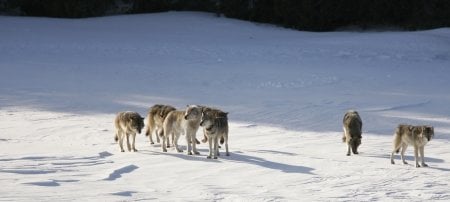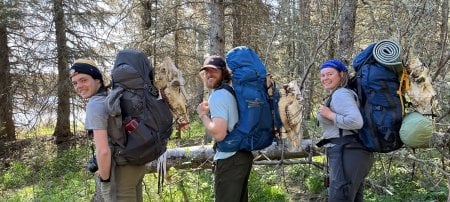Winter research on Isle Royale is done on skis and by plane.
A line of spruce trees stark against the white. On every horizon, indigo ice honeycombed or wind- polished. Snow dunes echo the ridges of the island.
From densely clumped balsam fir, a dark shape emerges. An elderly moose struggles through deep snow, its breath rapid clouds of desperation. Moments later, smaller shapes burst through the tree line, their own breath the vapor of hope. The wolves and moose of Isle Royale have for decades engaged in this dance of survival, keeping each other in check.
The moose stumbles and the wolves see their chance. Soon, they will eat a meal that will satisfy their hunger for a week. Soon, the ground will bear evidence of the life-and-death struggle, circles of scarlet on the snow.
The silence is broken by the low hum, growing louder, of an airplane's engine. In the pewter sky, just above the trees, a pilot and an ecologist stare down on the scene below. The ecologist frees a camera from her heavy coat, where its battery is kept warm by her body heat. The cockpit of the 1946 Champ is cold as subzero air arcs over the fuselage. The pilot expertly tilts the plane while the ecologist presses her finger to the shutter button.
Across the island to the east, the snow is crisscrossed by two pairs of skis. Two figures, bundled against the chill, climb a ridge, scrambling over fallen trees and skirting tree wells. They stop, and one kneels to examine snow packed into a bed of sorts. The pair collects moose pellets into a bag and takes clippings of a recently browsed fir tree. Samples collected, the man and woman pause. They reach for insulated water bottles, and the sharply sweet odor of Tang rises in the air. They nibble peanut butter sandwiches, then put their gloves back on and drop down the backside of the ridge, their skis etching easily through the snow.
Michigan Tech's Winter Study is the longest running examination of a predator-prey relationship in the world—2020 is its 62nd year. The data collected over the decades on Isle Royale, a 45-mile-long island in Lake Superior, has shaped the way humans understand how wolves and moose interact. The island's remote and wild nature makes it the perfect laboratory to understand predation, herbivory, and genetic adaptation. But the remote and wild nature also make the work difficult to conduct.
Supporting the Winter Study research and Michigan Tech ecologists are the National Park Service, the National Science Foundation, and the donations of hundreds of people. But the project heavily relies on four people—two pilots and two wildlife biologists who also happen to be incredibly talented skiers. Don Glaser and Don Murray fly small prop planes to study the wolves and moose from the air. Ky Koitzsch and Lisa Osborn Koitzsch have expanded the use of backcountry skiing for winter fieldwork in Isle Royale and Yellowstone national parks.
Blazing Trails
Koitzsch and Osborn Koitzsch have been skiing for science since 2008, first in Yellowstone and now Isle Royale. In both national parks, the couple has aided researchers by collecting fecal and urine samples as well as samples of what the studied animals eat. In the winter, there is only one road through Yellowstone; on Isle Royale there are no roads across the island. The fastest way to travel through the backcountry is on skis.
"In Yellowstone and Isle Royale, much of the winter work was done on snowshoes, but it was slow and inefficient," Koitzsch says. "We've improved the way the fieldwork is conducted and expanded the range where data is collected. It's fun. We've been teaching people to travel more efficiently in the backcountry."
This work includes using proper equipment—the pair use Madshus Epoch light backcountry telemark skis fitted with skins to allow them to go uphill as well as down—and knowing how to layer against the elements in order to ski for eight hours and cover six to 10 miles daily in temperatures ranging from 10 degrees below zero Fahrenheit to 20 degrees above.
"We love the cold and the peace and solitude of the wilderness," says Koitzsch. "There's really nothing we'd rather be doing than learning about the wildlife we enjoy in a setting like Isle Royale. For us, it's exhilarating."
The daily work of collecting samples on Isle Royale includes skiing a grid around Windigo, on the western side of the island, or near Daisy Farm, on the eastern side. These locations are nearest where the moose congregate in the winter, and consequently where the wolves spend the most time, too.
Koitzsch and Osborn Koitzsch collect matched pellet and urine samples from as many different moose as possible to help Michigan Tech researchers conduct microhistology, the study of fecal matter under a polarized light microscope to determine what an animal ate and how that plant affects the animal's physiology.
"Every day is different because we're always going to different places," Osborn Koitzsch says. "Our tasks are the same: collecting vegetation samples, moose pellet and urine samples. But our days are never the same. We're skiing across, climbing up and down based on the topography and terrain."
At night, the skiers rendezvous with researchers and pilots at Windigo, where the business of tucking into a fortifying dinner is taken seriously. Over the snap and spark of the fire in the woodstove and the warm, comforting smell of bread baking, the tiny group of humans—separated from their own species by many miles—read, play cards, and plan the days ahead. Winter Study is just seven weeks each year, yet it is a cocoon of focused research and the basis of lifelong friendships.
"Finding such adaptable people who are willing to work incredibly hard for eight hours a day in bitter cold and live under such primitive conditions, yet also be such a pleasure and fun to work with, that's why Don Glaser, Don Murray, and Ky and Lisa are so important to this project," says Sarah Hoy, research assistant professor in the College of Forest Resources and Environmental Science (CFRES) and the newest ecologist on the project.
Aerials in the Sky
Though the skiers are efficient, an essential form of travel to track the wolves and moose of Isle Royale is by air. Since the beginning of the predator-prey project in 1958, small aircraft and the pilots who fly them have played a pivotal part. Don Glaser, who is in his 80s, has been a part of the project since nearly the beginning. Don Murray is the grandson of another Don Murray, who was the first long-term pilot on the project.

Rolf Peterson, CFRES research professor and the project's longest-serving scientist, came to Isle Royale first as a graduate student in the 1970s, borne through the sky in Murray's Aeronca Champ. John Vucetich '94 '99, CFRES distinguished professor and the project's lead ecologist, cut his teeth on the project from the cabin of Glaser's Super Cub.
"Everything that I have learned about how to observe wildlife from an aircraft, I've learned from Don Glaser," Vucetich says. "For the first few years (of the Winter Study aerial survey), I felt like a secretary. I just wrote down what Don told me to write down."
Murray was raised on his grandfather's stories of the island, and so it's hardly surprising that one day he would also serve as a pilot for the project. Murray works as a game warden for the state of Minnesota and takes vacation time every year to fly the skies above Isle Royale.
"My wife likes to joke with our friends that I'm out lounging on some island," Murray says with a smile.
In reality, Murray and Glaser spend their days flying ecologists on aerial survey, maintaining their airplanes and making sure the plane skis don't freeze to the ice, chopping wood and hauling water, and taking turns with the rest of the crew making dinner.
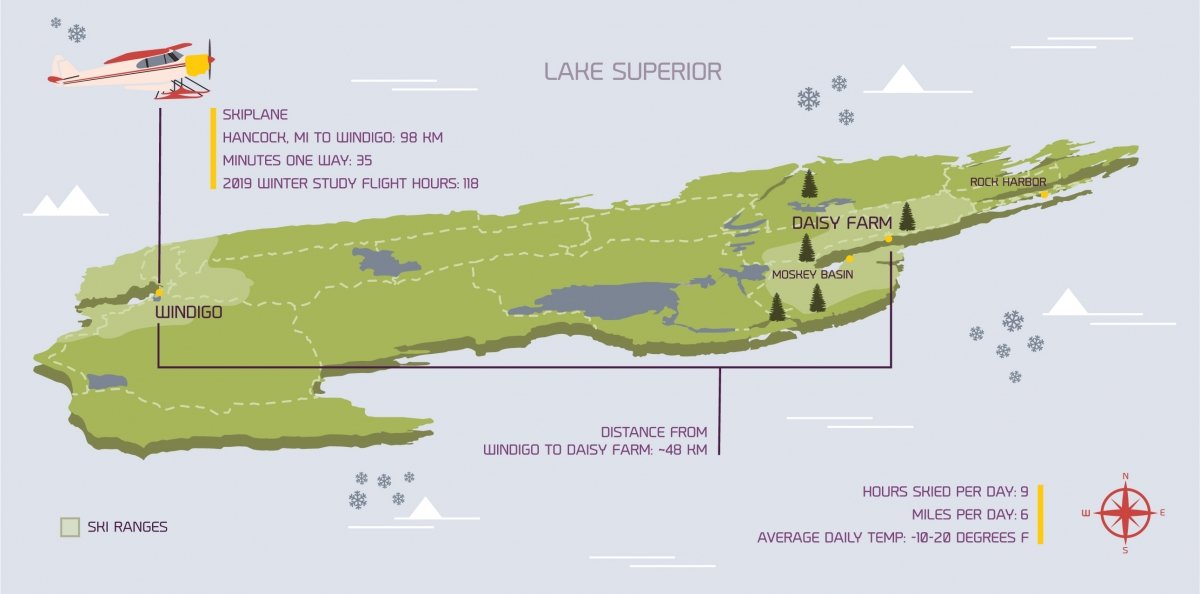
"We're always looking for tracks," Murray says. "We're flying, zigzagging in and out of bays. Sometimes we come around the corner, and there are the wolves on the ice. Or we find a moose kill. On every flight there is some kind of find, whether a kill we didn't know about or wolf tracks.
"It's hard to see the tracks from the plane. Windblown areas give you a time frame on whether the tracks are fresh or if the wind picked up and filled them in. It's a bit of an art I'm still learning. My grandfather had it perfected."
Murray's grandfather retired his wings when his eyesight began to fail and sold the 1946 Champ airplane. Years later, Murray's father by chance found the plane parked unused in a Minnesota field. Murray bought the plane back, and with its restoration and newly updated red-and-white paint job, the aircraft looks like not a moment has passed since its first flights above the island.
"The airplane I fly is a time machine. It's as close as walking in my grandfather's footsteps as I can possibly get," Murray says. "We're flying the same airplane, flying the same ecologist. My grandfather flew Rolf as a PhD student, and I've got Rolf as an old wise-hat teacher."
Murray's affection for the island is heartfelt.
"I like flying along the coast looking for wolf tracks, all the islands and bays," he says. "The big ice formations, the high cliffs, the way the water puts big icicles that hang off the cliffs. The wind comes along and pushes the ice chunks up in heaves. They become beautiful blue-colored pyramids, a mosaic."
Like tracks in the snow, the island's moose and wolves have cut paths through the field of ecology. Alongside them are the tracks of skis—telemark and airplane—written into the story of Isle Royale.
Michigan Technological University is an R1 public research university founded in 1885 in Houghton, and is home to nearly 7,500 students from more than 60 countries around the world. Consistently ranked among the best universities in the country for return on investment, Michigan's flagship technological university offers more than 185 undergraduate and graduate degree programs in science and technology, engineering, computing, forestry, business, health professions, humanities, mathematics, social sciences, and the arts. The rural campus is situated just miles from Lake Superior in Michigan's Upper Peninsula, offering year-round opportunities for outdoor adventure.
